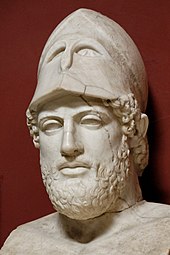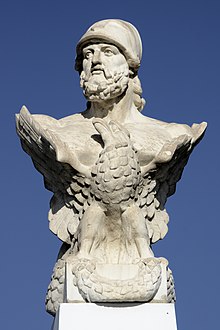Elpinice
Elpinice(Ancient Greek:Ἐλπινίκη Μιλτιάδου Λακιάδου,romanized:Elpinikē Miltiadou Lakiadou,flourished c. 510-450 BC)[1]was a noblewoman ofclassical Athens.Part of the Cimonids (related toCimon), her high status in society through birth and marriage influenced her outspoken nature as seen in Plutarch's works.

Family
[edit]She was the daughter ofMiltiades,tyrant of the Greek colonies on theThracian Chersoneseand Hegesipyle, daughter ofKing Olorusof Thrace. She was the sister ofCimon,an important Athenian political figure, and half-sister ofMetiochus(eldest son of Miltiades, from a prior marriage).[2]She is known fromPlutarch's life ofPericles,where she appears twice in political confrontations with the Athenian statesman.[3]Herodes Atticusclaimed his lineage from Miltiades from Elpinice, and namedhis daughterafter her. At her death she was buried with members of her own family by birth and not her husbands, showing her piety towards her blood family.[4][2]
Marriage and romantic affiliations
[edit]

Greek law allowedmarriage between a brother and sisterif they had different mothers.
Some accounts[6]say that Elpinice was for a time married to her brother, but was later given as a bride toCallias II,one of the richest men in Athens, who had fallen in love with her. Rumors of incestuous conduct between Cimon and Elpinice were prominent enough that archaeologists have foundostraconsreflecting the rumors.[2]It is possible that[2]Callias had made marriage to Elpinice the condition for paying, on Cimon's behalf, the fine which had been imposed upon their father Miltiades and for which Cimon had inherited responsibility.[7]
Callias and Elpinice probably married in the early 480s BC. By Callias, Elpinice was the mother ofHipponicus;Callias and Elpinice probably divorced after he was born.[8]
She was a lover to the artistPolygnotusofThasoswho used her features in his work depicting theTrojanwomanLaodice.[9][10]
Political and military associations
[edit]Miltiades was one of the major forces securing a victory in the Battle at Marathon during the Greco-Persian Wars. Elpinice, at the time, was still a child and not of age. She would have left Athens during the battle.[2]
When Cimon was charged with treason for taking bribes fromAlexander I, king of Macedonia,she negotiated his acquittal with Pericles.[11]

When the people of the island ofSamosrevolted against Athenian rule, Pericles pursued a war against them and punished them by demolishing their city walls, confiscating their ships and forcing them to pay a large fine. Rather than celebrate the victory Elpinice was a lone voice who pointed out that it was won over Athens' own people rather that against her true foreign enemies such as thePhoeniciansorMedes.[12]Pericles rebuked her with the words "As an old woman you should not anoint yourself with oils." Which shows Pericles' views on women in Athenian political society, and how Elpinice might have been viewed by the men in the public sphere. Elpinice was one of the few women in antiquity who is shown to speak in public.[13]
References
[edit]- ^Byrne, Sean G."Ἐλπινίκη of Lakiadai".Athenian Onomasticon.Retrieved1 February2024.
- ^abcdeNevin, Sonya (2022).The Idea of Marathon.Bloomsbury Academic.doi:10.5040/9781350157620.ISBN978-1-350-15762-0.S2CID246191396.
- ^Plutarch."Pericles".The Internet Classics Archive. Translated by Dryden, John. Cambridge:Massachusetts Institute of Technology.
- ^Cox, Cheryl Anne (1998).Household Interests: Property, Marriage Strategies, and Family Dynamics in Ancient Athens.Princeton University Press. p. 114.ISBN978-0-691-01572-9.
- ^"Robert, Carl: Hallisches Winckelmannsprogramm (Band 17): Die Iliupersis des Polygnot (Halle a. S., 1893)".digi.ub.uni-heidelberg.de.Retrieved2023-06-01.
- ^Evelyn-White, Hugh G. (1914)."Plutarch's Lives - Plutarch's Lives, with an English Translation by Bernadotte Perrin, in ten volumes. Vol. I.: Pp. xix + 582; Vol. II.: Pp. ix + 631. Small 8vo. London: William Heinemann. New York: The Macmillan Company, 1914".The Classical Review.30(3): 89–90.doi:10.1017/s0009840x00010118.ISSN0009-840X.S2CID96477749.
- ^Lahanas, Michael (2006)."Elpinice".Hellenic World Encyclopaedia.Hellenica. Archived fromthe originalon 2009-09-21.Retrieved2009-06-06.
- ^Nails, Debra (2002).The People of Plato.Hackett. pp. 172–173.
- ^Lewis, D.M.; Boardman, John; Davies, J.K.; Ostwald, M., eds. (1992).The Cambridge Ancient History.Vol. V: Fifth Century B.C. (second ed.). Cambridge University Press. p. 317.ISBN978-0-521-23347-7.
- ^Laurin, Joseph (2005).Women of Ancient Athens.Trafford Publishing. pp. 181–182.ISBN978-1-4122-3405-4.
- ^Plut. Cim. 4, 14,PericlesArchived2009-06-28 at theWayback Machine.10; Nepos, Cim. 1
- ^"PERICLES AND ELPINICE".Yesterday's Classics.The Baldwin Project. 2000–2008.Retrieved2009-06-06.
- ^O'Higgins, Laurie (2003).Women and Humor in Classical Greece.Cambridge University Press. p. 113.ISBN978-0-521-82253-4.
